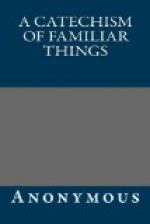Acrid, of a hot, biting taste.
Aromatic, fragrant, having an agreeable odor.
What is Cinnamon?
An agreeable, aromatic spice, the bark of a tree of the laurel kind; the Cinnamon tree grows in the Southern parts of India; but most abundantly in the island of Ceylon, where it is extensively cultivated; its flowers are white, resembling those of the lilac in form, and are very fragrant; they are borne in large clusters. The tree sends up numerous shoots the third or fourth year after it has been planted; these shoots are planted out, when nearly an inch in thickness.
How is the bark procured?
By stripping it off from these shoots, after they have been cut down; the trees planted for the purpose of obtaining cinnamon, throw out a great number of branches, apparently from the same root, and are not allowed to rise higher than ten feet; but in its native uncultivated state, the cinnamon tree usually rises to the height of twenty or thirty feet.
How is the Cinnamon Tree cultivated?
By seed, sown during the rains; from shoots cut from large trees; and by transplanting old stumps. The cinnamon tree, in its wild state, is said to be propagated by means of a kind of pigeons, that feed on its fruit; in carrying which to their nests, the seeds fall out, and, dropping in various places, take root, spring up, and become trees.
Propagated, spread, extended, multiplied.
What else is obtained from this tree?
The bark, besides being used as a spice, yields an oil highly esteemed, both as a medicine and as a perfume; the fruit by boiling also produces an oil, used by the natives for burning in lamps; as soon as it hardens, it becomes a solid substance like wax, and is formed into candles. Camphor is extracted from the root. Cassia is cinnamon of an inferior kind.
CHAPTER V.
BOMBAZINE, CRAPE, CAMLET, CAMBRIC, LACE, SILK, VELVET, AND MOHAIR.
What is Bombazine?
A stuff composed of silk and wool woven together in a loom. It was first made at Milan, and thence sent abroad; great quantities are now made in England and other countries.
Where is Milan situated?
In Italy, and is noted for its cathedral.
For what is Bombazine used?
For dresses. Black bombazine is worn entirely for mourning. The original bombazine has, however, become much less used than formerly, on account of the numerous newly-invented fabrics of finer or coarser qualities, composed of the same materials mixed in various degrees, as Mousselines de laine, Challis, &c.
What is Crape?
A light, transparent stuff, resembling gauze, made of raw silk very loosely woven, or of wool; by raw silk is meant, silk in the state in which it is taken from the silk worm.
Where was Crape first made?




